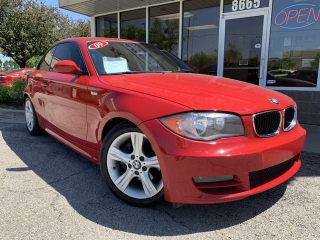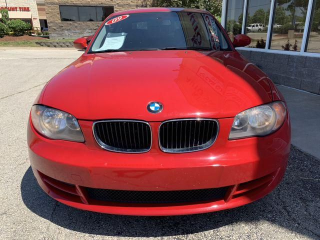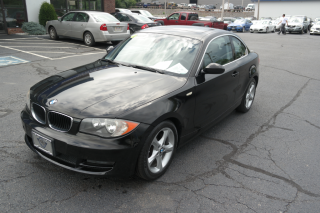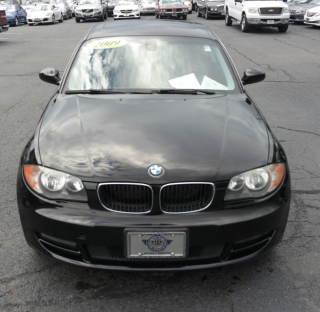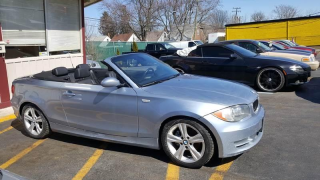The Good
Its key advantages include exceptional performance with precise handling and powerful engine options (especially the 135i), appealing to emotional drivers. Practical buyers appreciate its relatively compact size for city driving, premium interior feel, and a strong used market value for the performance offered. Design-wise, it carries the distinctive BMW aesthetic, while fuel efficiency is decent for a luxury performance vehicle.
The Bad
Known weaknesses include cramped rear seating and a small trunk, limiting practicality. The 135i's N54 engine is notorious for High-Pressure Fuel Pump (HPFP) failures and carbon buildup. Maintenance costs are higher than average, and the ride can be firm due to its sporty suspension and run-flat tires. Electrical gremlins can also occur with age.
2009 BMW 1-Series: Quick Overview
- Engine Options:
- 128i: 3.0-liter N52 naturally aspirated inline-six cylinder
- 135i: 3.0-liter N54 twin-turbocharged inline-six cylinder
- Horsepower:
- 128i: 230 hp @ 6,500 rpm
- 135i: 300 hp @ 5,800 rpm
- Fuel Economy (EPA estimates for 2009, City/Highway MPG):
- 128i Coupe (Manual): 18/28 MPG
- 128i Convertible (Manual): 18/27 MPG
- 135i Coupe (Manual): 17/25 MPG
- 135i Convertible (Manual): 17/25 MPG
- 0-60 mph Times (approximate):
- 128i: 5.9-6.3 seconds
- 135i: 4.8-5.2 seconds
- Towing Capacity: Not rated or recommended for towing in the U.S. market.
- Trim-Level Features:
- 128i: Standard features include 17-inch alloy wheels, automatic headlights, fog lights, rain-sensing wipers, automatic climate control, a 10-speaker audio system with CD/MP3 player, auxiliary input, and HD radio. Optional packages included the Sport Package (sport suspension, sport seats, larger wheels), Premium Package (leather upholstery, power front seats, BMW Assist, Bluetooth), and Cold Weather Package (heated front seats).
- 135i: Builds on the 128i with the more powerful N54 twin-turbo engine, a firmer sport suspension, larger performance brakes, 18-inch wheels, M aerodynamic body kit, M-specific steering wheel, and a higher top speed limiter. Similar optional packages were available, plus additional premium audio and navigation system options. Both trims offered optional Xenon headlights, parking sensors, and a power moonroof (coupe). Convertibles featured a power-operated soft top.
2009 BMW 1-Series Specifications
Vehicle Information
| Year | 2009 |
| Make | BMW |
| Model | 1-Series |
| Trim | - |
| Style | Coupe 6-Speed Manual |
| Type | Coupe |
| Category | Subcompact Car |
Manufacturing Details
| Made In | Germany |
| Manufacturing City | LEIPZIG |
Dimensions
| Doors | 2-Door |
| Curb Weight | 1534.96 kg |
| Gross Vehicle Weight Rating | 2070.19 kg |
| Overall Height | 140.72 cm |
| Overall Length | 436.12 cm |
| Overall Width | 174.75 cm |
| Wheelbase Length | 265.94 cm |
| Standard Seating | 4 |
Engine & Performance
| Engine | 3.0-L L-6 DOHC 24V |
| Engine Size | 3L |
| Engine Cylinders | 6 |
| Transmission | 6-Speed Manual |
| Transmission Type | Manual |
| Transmission Speeds | 6-Speed |
| Drivetrain | Rear-Wheel Drive |
Additional Features
| Anti-Brake System | 4-Wheel ABS |
| Steering Type | Rack & Pinion |
Pricing
| Manufacturer Suggested Retail Price (MSRP) | $35,850 USD |
| Invoice Price | $32,980 USD |
| Delivery Charges | $825 USD |
Vehicle History Report
Specifications
History
Events
History Check
Check
Check
Check
Check
Listings
Recalls
Check
Analysis
What Problems Does the 2009 BMW 1-Series Have?
For the 128i's N52 naturally aspirated engine, common problems include leaks from the valve cover gasket and oil filter housing gasket. The electric water pump and thermostat are also known failure points across both engines, often failing without warning and leading to overheating. General long-term concerns include wear of suspension components like control arm bushings, leading to clunks and reduced handling precision.
Electrical issues, such as faulty window regulators, sensor failures (e.g., crank/camshaft position sensors), and iDrive glitches, can also arise. Run-flat tires, standard on these models, are expensive to replace and prone to bubbles. Recalls, beyond the HPFP, have included Takata airbag inflators and potential battery cable connection issues. Prospective owners should always check for a complete service history and ensure critical known issues have been addressed to mitigate costly repairs.
How long will the 2009 BMW 1-Series last?
What Technology & Safety Features are Included?
In terms of driver-assistance, standard features included Dynamic Cruise Control. Optional aids primarily comprised rear parking sensors. Safety features were comprehensive: Dynamic Stability Control (DSC) with Dynamic Traction Control (DTC), four-wheel anti-lock brakes (ABS) enhanced with Brake Fade Compensation, Brake Drying, and Brake Stand-by. Cornering Brake Control (CBC) further aided stability. The airbag system included dual front, front side, and full-length side curtain airbags for the coupe, while convertibles had front side airbags that extended upwards for head protection. Active front head restraints and a Tire Pressure Monitoring System (TPMS) were also standard. The optional BMW Assist telematics system provided emergency communication services.
Crash-Test Ratings:
The 2009 BMW 1-Series performed well in crash tests:
- IIHS (Insurance Institute for Highway Safety):
- Moderate Overlap Front: Good
- Side Impact (with side airbags): Good
- Rear Crash Protection/Head Restraints: Good
- Roof Strength: Good (Coupe), Acceptable (Convertible)
- NHTSA (National Highway Traffic Safety Administration):
- Frontal Crash: 4 stars (driver), 5 stars (passenger)
- Side Crash: 5 stars (front seat), 5 stars (rear seat)
- Rollover: 4 stars
What Colors Options are Available?
2009 BMW 1-Series Prices and Market Value
2009 BMW 1-Series Cost of Ownership
2009 BMW 1-Series Fuel Efficiency
2009 BMW 1-Series Safety Rating
NHTSA
IIHS
2009 BMW 1-Series Recalls & Defects
Seat Belts:front:retractor
Engine and Engine Cooling:cooling System:fan
2009 BMW 1-Series Warranty
Basic
Powertrain
Rust
2009 BMW 1-Series Insurance
reasonable repair costs.
How Does the 2009 BMW 1-Series Compare to Other Coupe?
In Performance, the 1-Series, with its rear-wheel-drive architecture, offered a more engaging and balanced feel than the FWD/AWD Audi A3 or FWD GTI. The 135i's twin-turbo N54 engine delivered significantly more power than most direct competitors, making it a performance bargain. The 128i provided a smooth, naturally aspirated BMW experience. The C-Class, while luxurious, was generally less sporty.
Features were competitive for its luxury class, offering a premium interior and good tech options like iDrive (though an older generation) and premium audio. Rivals like the A3 offered similar tech, while the GTI provided great value for features but lacked the same luxury feel.
Reliability is where the 1-Series has a mixed record. The 135i's N54 engine is notorious for costly HPFP failures, wastegate issues, and carbon buildup. The 128i's N52 engine is generally more reliable but still prone to electric water pump and gasket leaks. The Audi A3 and VW GTI, while not problem-free (e.g., carbon buildup, timing chain tensioners on certain engines), often present fewer critical, expensive-to-fix issues than the N54. The Mercedes C-Class also has its maintenance quirks, but arguably less severe than the N54's.
Regarding Price, especially in the used market, the 1-Series (particularly the 135i) offers fantastic performance for the money. However, this lower initial cost must be balanced against potentially higher long-term ownership costs due to reliability concerns.
Alternatives: For pure driving engagement, consider a slightly older Porsche Boxster/Cayman (higher running costs) or a Nissan 350Z/370Z (less refined). For a more reliable, still engaging compact, a VW GTI (Mk5/Mk6) or a newer generation Audi A3 might be better, trading RWD for FWD/AWD. For a naturally aspirated BMW, the 128i is a safer bet than the 135i for long-term reliability.
Final Verdict: Is the 2009 BMW 1-Series a Good Coupe?
However, this comes with a crucial condition: **only buy a well-documented example with comprehensive service records**, preferably with known issues like the 135i's HPFP or carbon buildup already addressed. A pre-purchase inspection by a BMW specialist is mandatory. The 128i offers a more reliable and economical entry into the 1-Series world. It's not suitable for budget-conscious owners unprepared for higher maintenance and potential repair costs, but for the informed enthusiast, it's a highly rewarding driver's car.
